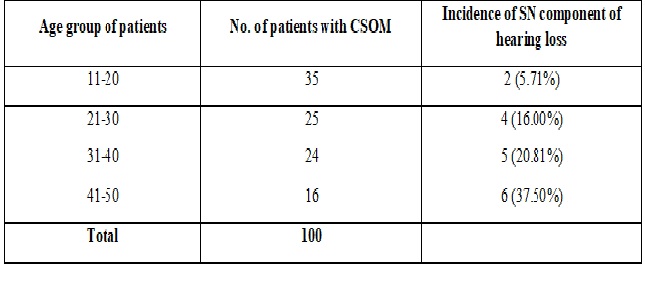Study of pattern of hearing loss in CSOM (chronic suppurative OTITIS media)
Abstract
Introduction: Chronic suppurative otitis media is one of the most common conditions encountered by Otologists in daily practice. Conventionally hearing loss in CSOM is conductive in nature, but it has been observed that some patient displayed an additional sensorineural component to their conductive hearing loss (mixed hearing loss).
Material and Methods: A prospective cohort observational study on 100 Cases in two groups of 50 each who had safe CSOM and 50 unsafe CSOM conducted over a period of July 2011 to September 2013 at the Department of Otorhinolaryngology, Padmashree Dr. D. Y. Patil Medical College, Hospital and Research Centre (DPU), Pimpri, Pune. Detailed history, complete ENT examination was done. They were then subjected to Puretone audiometry; air and bone conduction thresholds were tested and plotted on the audiogram. Univariate and multivariate logistic regression (odds ratio) analyses were used.
Results: Incidence of hearing loss is 72%for conductive type and 28% is of mixed type, in which 72% are of safe conductive, 18% safe mixed type and 64% are of unsafe conductive, 36% are in unsafe mixed type. Incidence of SNHL increases as age increases being maximum in age group of 41-50 years i.e. 37.50% and minimum in 11-20 years i.e. 5.71%. 14% cases of unsafe chronic suppurative otitis media were found to be associated with labyrinthine fistula. This proved to be the commonest cause of sensorineural component in unsafe chronic suppurative otitis media followed by granulation over oval window (8%) and cholesteatoma extending to round window in 4 % of cases.
Conclusion: In the present study incidence of sensorineural hearing loss increased with advancing age, showing that age is a risk factor for sensorineural component of hearing loss in CSOM though conductive hearing loss is more common. CSOM is associated with mixed hearing loss mainly >35dB, higher frequencies were involved.
Downloads
References
2. Acuin J. Review Extracts from Concise clinical evidence: Chronic suppurative otitis media.vBMJ. 2002 Nov 16; 325(7373):1159; discussion 1159.[pubmed]
3. Miura MS, Krumennauer RC, Lubianca Neto JF Intracranial complications of chronic suppurative otitis media in children. Braz J Otorhinolaryngol. 2005 Sep-Oct; 71(5):639-43.[pubmed]
4. Mostafa BE, El Fiky LM, El Sharnouby MM.Complications of suppurative otitis media: still a problem in the 21st century. ORL J Otorhinolaryngol Relat Spec. 2009; 71(2):87-92.[pubmed]
5. Mills RP (1997) Management of chronic suppurative otitis media. In: Kerr AG, Booth JB (eds) Scott-Brown’s otolaryngology, vol. 3, 6th edn. Butterwoth-Heinemann, Oxford, p 3/10/4 [Ref list]
6. Verhoeff M, van der Veen EL, Rovers MM, Sanders EA, Schilder AG.Chronic suppurative otitis media: a review. Int J Pediatr Otorhinolaryngol. 2006 Jan; 70(1):1-12.[pubmed]
7. Jensen RG, Koch A, Homøe P.The risk of hearing loss in a population with a high prevalence of chronic suppurative otitis media. Int J Pediatr Otorhinolaryngol. 2013 Sep; 77(9):1530-5.[pubmed]
8. Miura MS, Krumennauer RC, Lubianca Neto JF (2005)Intracranial complications of chronic suppurative otitis media in children. Braz J Otorhinolaryngol 71(5):639–643..[PubMed
9. Amali A, Hosseinzadeh N, Samadi S Sensorineural hearing loss in patients with chronic suppurative otitis media: Is there a significant correlation? Electron Physician. 2017 Feb 25;9(2):3823-3827. doi: 10.19082/3823. eCollection 2017 Feb.[pubmed]
10. Maharjan M, Kafle P, Bista M, Shrestha S, Toran KC. Observation of hearing loss in patients with chronic suppurative otitis media tubotympanic type. Kathmandu Univ Med J (KUMJ). 2009 Oct-Dec;7(28):397-401.[pubmed]
11. Silveira Netto LF1, da Costa SS, Sleifer P, Braga ME.The impact of chronic suppurative otitis media on children's and teenagers' hearing. Int J Pediatr Otorhinolaryngol. 2009 Dec;73(12):1751-6. doi: 10.1016/j.ijporl.2009.09.033. Epub 2009 Oct 23.
12. Orji FT, Agu CC.Patterns of hearing loss in tympanic membrane perforation resulting from physical blow to the ear: a prospective controlled cohort study. .Clin Otolaryngol. 2009 Dec;34(6):526-32. doi: 10.1111/j.1749-4486.2009.02035.x.[pubmed]
13. Redaelli de Zinis LO, Campovecchi C, Parrinello G Predisposing factors for inner ear hearing lossassociation with chronic otitis media. Int J Audiol. 2005 Oct;44(10):593-8.[pubmed]
14. Papp Z, Rezes S, Jókay I, Sziklai I Sensorineural hearing loss in chronic otitis media.Otol Neurotol. 2003 Mar; 24(2):141-4.[pubmed]
15. Kolo ES, Salisu AD, Yaro AM, Nwaorgu OG. Sensorineural hearing loss in patients with chronic suppurative otitis media. Indian J Otolaryngol Head Neck Surg. 2012 Mar; 64(1):59-62.[pubmed]
16. Noordzij JP, Dodson EE, Ruth RA, Arts HA, Lambert PR.Chronic otitis media and sensorineural hearing loss: is there a clinically significant relation?Am J Otol. 1995 Jul; 16(4):420-3.[pubmed]
17. Kaur K, Sonkhya N, Bapna AS. Chronic suppurative otitis media and sensorineural hearing loss: Is there a correlation?Indian J Otolaryngol Head Neck Surg. 2003 Mar; 55(1):21-4.[pubmed]
18. Aslan Felek S, Islam A, Celik H, Demirci M, Samim E, Kose SK.The functional and anatomical results of the canal wall down tympanoplasty in extensive cholesteatoma. Acta Otolaryngol. 2009 Dec; 129(12):1388-94.[pubmed]
19. r. Pareschi, D. Lepera, and R. Nucci. Canal wall down approach for tympano-mastoid cholesteatoma: long-term results and prognostic factorsr. Pareschi, D. Lepera, and R. Nucci. Canal wall down approach for tympano-mastoid cholesteatoma: long-term results and prognostic factorsCanal wall down approach for tympano-mastoid cholesteatoma: long-term results and prognostic factors Canal wall down approach for tympano-mastoid cholesteatoma: long-term results and prognostic factors .Acta Otorhinolaryngol Ital. 2019 Apr; 39(2): 122–129.doi: 10.14639/0392-100X-2237.

Copyright (c) 2019 Author (s). Published by Siddharth Health Research and Social Welfare Society

This work is licensed under a Creative Commons Attribution 4.0 International License.


 OAI - Open Archives Initiative
OAI - Open Archives Initiative



















 Therapoid
Therapoid

